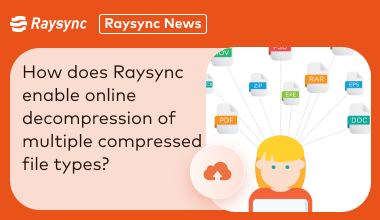�【2024】What is the best photo cloud storage tool?
In the digital era, the importance of securely managing and storing photo files cannot be overstated. With the rising volume of digital content, especially high-resolution images, the need for reliable photo cloud storage solutions is more crucial than ever. This article explores the best tools for uploading image files securely to cloud storage, ensuring professional assets are well-protected and easily accessible.
Part 1: Factors to Consider When Choosing Online Storage for Photos
Choosing the right platform for image upload to secure cloud file storage involves several critical factors:
-
Storage Space:
Some cloud services offer unlimited storage, while others have a cap. The higher the resolution of the image, the larger the storage space. So choose a service that can accommodate your growing library without frequent upgrade plans.
-
Price:
Consider both the initial cost and the long-term expense. Free services may be suitable for casual users, but professional photographers or those with extensive collections might need a paid plan. Look for a cloud storage tool that offers flexibility and scalability according to your needs.
-
Security:
How these cloud storage platforms ensure the safety and privacy of your uploaded image files to cloud storage. Understanding the provider's data recovery and backup policies is also crucial in case of accidental deletions or system failures.
Part 2: The 5 Best Photo Storage Tools
Method 1: Raysync Cloud
-
What it does: Provides high-speed, large file transfer services designed for small teams, with no deployment necessary.
-
Strengths: High-speed transfers, peer-to-peer capabilities, encrypted communication, 2TB of transfer traffic, and 1TB of cloud storage. Suitable for small to medium businesses focusing on efficiency.
-
Weaknesses: May not be as well-known as other platforms, and its focus on small teams might limit functionality for individual users or larger enterprises. For more details, visit Raysync Cloud.
Method 2: Google Drive
-
What it does: Offers cloud storage with seamless integration with Google's ecosystem, including Google Photos.
-
Strengths: Easy sharing, strong collaboration tools, and good integration with other Google services.
-
Weaknesses: Privacy concerns, limited free storage, and occasionally complicated file organization.
Method 3: OneDrive
-
What it does: Microsoft's cloud storage solution, integrated with Microsoft Office and Windows.
-
Strengths: Seamless integration with Microsoft products, good for document and photo storage, and offers automatic photo backup.
-
Weaknesses: Limited free storage space and some issues with file syncing.
Method 4: Backblaze
-
What it does: Specializes in backup services, including cloud storage for photos.
-
Strengths: Unlimited storage options and strong backup capabilities.
-
Weaknesses: Interface might not be as intuitive, more focused on backup rather than cloud storage features.
Method 5: SmugMug
-
What it does: A photo-sharing website and image hosting service tailored for professional photographers.
-
Strengths: Excellent for displaying and selling photographs, offers robust customization for galleries.
-
Weaknesses: More expensive, specifically tailored to professional photographers, which might not suit casual users.
Conclusion
To sum up, there are numerous methods for safely transferring picture data to cloud storage to meet various large-scale picture storage requirements. Although Raysync Cloud is not a specialized storage tool, it implements powerful authentication and encryption techniques to safeguard the integrity and privacy of submitted image files. For businesses managing sensitive visual data or professional photographers, Raysync cloud provides a comprehensive and safe way to transfer photo files to cloud storage. However, every platform has distinct features and caters to different demands, so the features you prioritize for sharing and storing your images, your budget, storage requirements, and security considerations will all play a role in which platform you choose.
You might also like

Raysync News
April 12, 2024How does Raysync enable online decompression of multiple compressed file types?
Many compressed files are transferred to a file server. Users are unable to view or preview them. The ability to unzip files online on the server solves this problem and significantly improves the customer experience in a variety of ways.

Raysync News
December 21, 2020The Best Way to Fast File Transfer Between Two Computers
This article mainly introduces the best way to fast file transfer between 2 computers.

Raysync News
April 14, 2020How to transfer large files: file transfer glossary for video professionals
Are you familiar with file transfer? Are you still looking for a large file transfer tool? Do not worry. We have prepared a glossary about file transfer just for you